Japanese Candlesticks for Online Trading
Contrary to what some of you might think, trading naked does not mean trading with no clothes on, but using charts free of any indicators. This is where Japanese candlesticks play an important role because the shapes they take and the patterns they form are an indication of future price direction. A Japanese candle shows us the Open, High, Low and Close of the period analyzed. If we are using a Daily chart, one completed candlestick will give us the highest point reached by price during the day, the lowest price, the open price, and the close price. The same goes for a 1-hour candle or a 1-minute candle (this applies to all Japanese candles). Here is a graphic explanation:
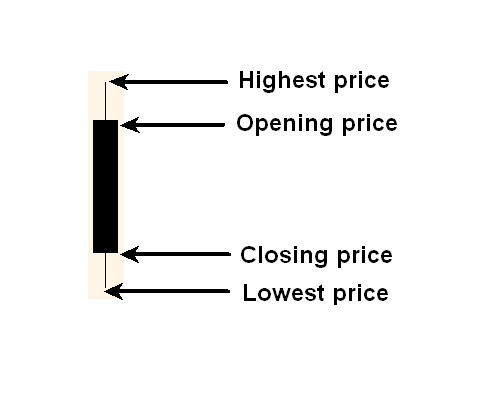
This is a bearish candle, which means that the Closing price is lower than the Opening price (the price fell by the end of the analyzed period). The upper wick shows the highest point reached by price and the lower wick shows the lowest point reached by price in our period. This is the basic information that we get from a Japanese candlestick but now comes the interesting part: I am going to explain how to use some of the most important Japanese candlesticks.
How to Use Different Types of Japanese Candlesticks
The Pin Bar
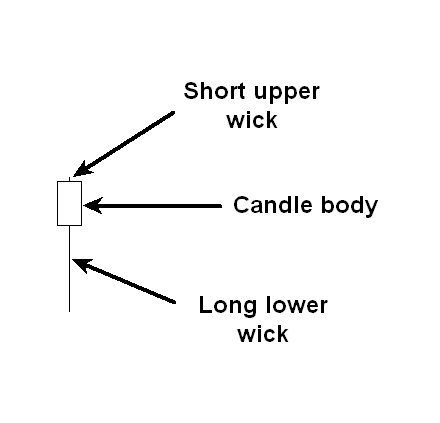
This is one of the most powerful candlesticks and you might remember it from the Pinocchio Strategy. The Pin bar (Pinocchio or simply Pin) tells a story and we must know how to read it: in the beginning, the Bears were strong and confident, pushing price lower, but by the end of the period, the Bulls starting to become more and more powerful, pushed price higher than the opening point and managed to close it higher, with a small upper wick. After a candle like this one, the Bulls are in control and prices are more likely to move even higher. A Bullish Pin bar has the following characteristics: it has a big lower wick, a small body (the body is about one-third of the length of the whole candle) and a small upper wick. A Bearish Pin is an opposite. You will not always see perfect Pin bars like the one in our picture above, but they can still be categorized as a Pin. Sometimes in a Bullish Pin, the closing price will not be higher than the opening price. That is still a Bullish Pin bar, but it will not be as powerful as the one in our picture.
Doji Candle
A Doji candle is formed when the Open price and Close price are almost the same, which will create a very small body and long wicks. Usually, in a Doji candle, the upper and lower wicks are almost the same length, but if they are not, the candle still qualifies as a Doji as long as the opening price and the closing price are almost the same. Look at the picture below to see what a Doji candle looks like:
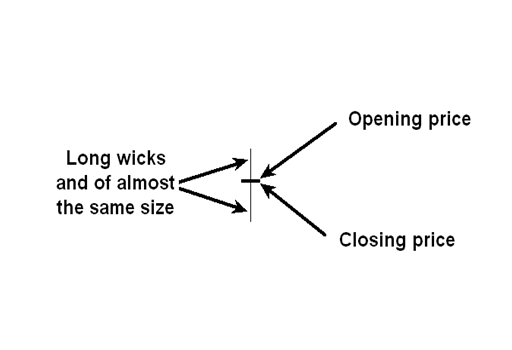
Usually the Doji candle signifies indecision in the market. Neither the Bulls nor the Bears can move price in one direction and this causes the price to fluctuate up and down during the period and eventually close almost at the same point where it opened. If after a strong, prolonged move in one direction, several Doji candles appear, we must be aware of a possible reversal, but given that the Doji is mainly an indecision sign, the price can go either way because eventually one of the two sides will win the battle.
Marubozu Candle
A Marubozu candle is a clear indication of one-sided strength: a bullish Marubozu means that the Bulls are in complete control and a bearish Marubozu candle signifies that the Bears are in total control. Here is how Marubozu candles look like:
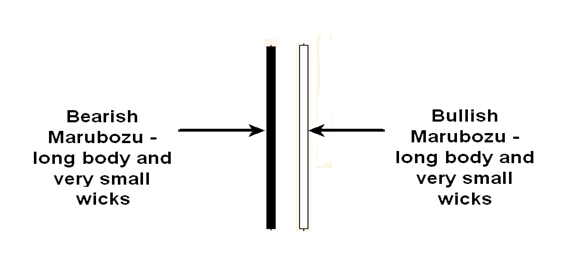
Marubozu is a single candlestick, not a formation and in the picture above I exemplified both Bearish and Bullish ones, but that doesn’t mean that you have to find them together to qualify as a Marubozu. The characteristics of this type of candle are long bodies, signifying strong selling or buying pressure (depending on the type of candle – bullish or a bearish) and no upper or lower wicks, signifying that the other side of the market has no power. Although a perfect Marubozu is hard to find, when we find one it is a clear indication that price will continue in the direction indicated by it. One more important and helpful thing to know is that whenever you see a breakout accompanied by a Marubozu candle, it is most likely to be a real breakout and not a false one. Here is a picture:
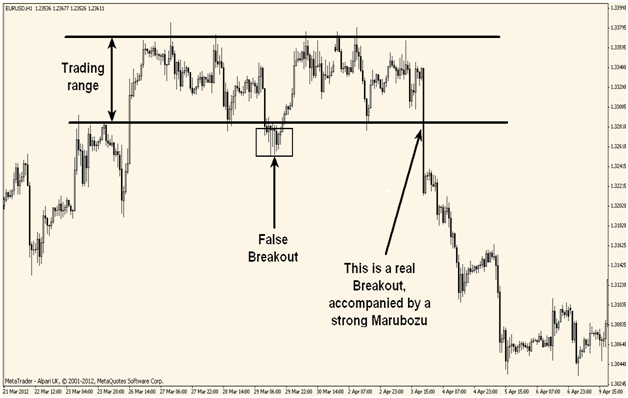
In the picture above, the price was confined to a range, finding Resistance at the top and Support at the bottom. About halfway into the ranging period, price tried to escape to the downside, but that resulted in a false breakout as we can see. Then again, price tried to break the bottom of the range, but this time, a Marubozu appeared and the breakout was clearly confirmed by it.
Japanese Candles – Candle Formations
Ok, guys, this is where it gets a bit more complicated because we are going to talk about formations composed of two candles. So far, we covered the basics, explaining how a candle is formed and presenting you three of the most important types of candles, the Pin, Doji, and Marubozu. In this second part of the article, we will up our game and take a look at double-candle formations, which means that more attention must be paid to both candles. Let’s get down to business and start talking about the first formation.
Engulfing Pattern
The name gives us a hint about the formation, but I want to make sure everything is crystal clear. In a valid engulfing formation, the second candle totally engulfs the body of the first one. The bullish engulfing is formed of a bearish candle followed by a larger bullish candle and the bearish engulfing is formed of a bullish candle followed by a larger bearish candle. In the picture below we have the bullish engulfing to the left and the bearish engulfing pattern to the right.
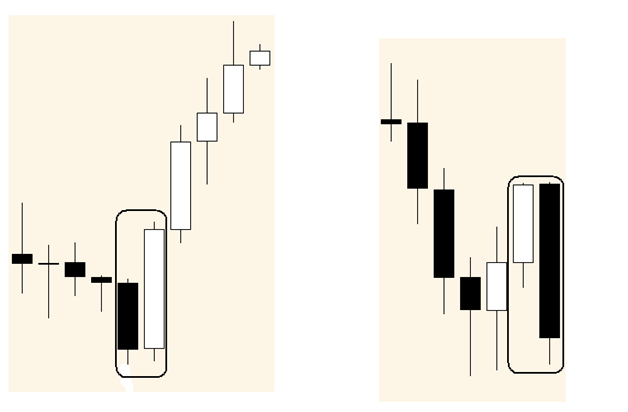
A bullish engulfing pattern can appear after a down move or a period of consolidation and it shows us that the bulls, after a good rest and an energy drink are strong enough to start taking control of the market. Their strength appears in the form of a big, engulfing candle. Sometimes the second candle can engulf more than one previous candle, just like in my picture above. Pay attention when that happens, because it’s an even stronger signal. The same principles apply to the bearish engulfing pattern. Often we can see the retracement ending with an engulfing formation and that’s a good time for us to join the resuming trend.
Tweezers
This type of pattern can usually be spotted after an extended move in either direction.
Tweezer Tops
Appear after an uptrend or an extended move up. The first candle must match the main trend or the latest move (so it will be a bull candle) and the second will be a counter trend candle (so it will be a bear candle), but both must test the same highs. Check out the picture below:
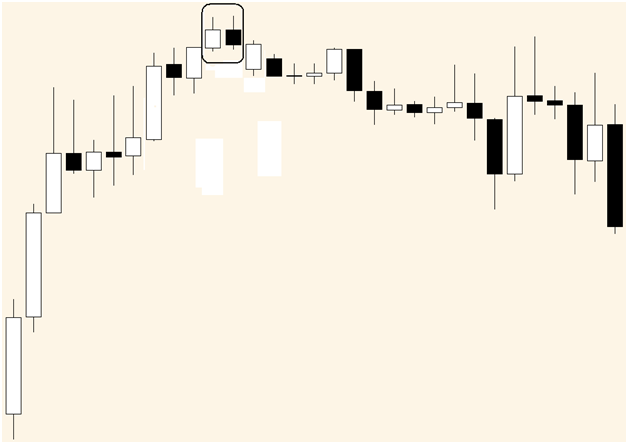
Notice the first candle is bullish and it’s followed by a bearish candle and they both test the same high point. After the candle formation is complete, price reverses and a down move starts.
Tweezer Bottoms
Appear after a downtrend or an extended down move. The first candle must match the main trend or the latest move (so it will be a bear candle) and the second will be counter-trend (bull candle), but they will both test the same low. Here is the picture to go with the explanation:
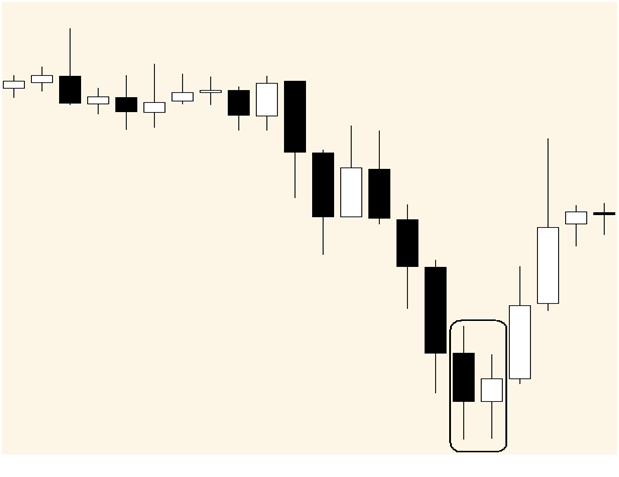
Again, notice the valid sequence: the first candle is the same as the recent move (down), the second is counter-trend (up) and both must test the same low point.
Tweezer bottoms and tops suggest strong support or resistance at that level and give us a hint that the level will hold and the price will reverse. They can mark the end of a trend, the beginning of a reversal or retracement or even the end of the retracement as they are reversal patterns. One more important point is that Tweezer bottoms or tops can look different than the ones I show on my pictures, but the sequence must be the same: trend candle – counter-trend candle – testing the same high/low.
Inside Bar
The last dual candlestick formation that we are going to talk about today is the Inside Bar. This is formed when the second candle has the Open and Close inside the range of the first. You could almost say that it is the opposite of the Engulfing pattern. Check out the picture:
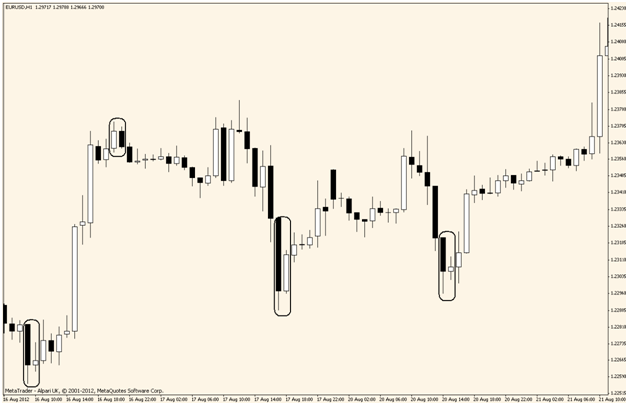
On the picture I have circled four inside bars and each one marks a reversal. Notice that the second candle (inside bar) in the formation has the Open and Close inside the range of the first candle, named Mother Bar. Inside bars can appear either in an uptrend or a downtrend and there are no special requirements like in the case of the Tweezers. Sometimes the Mother bar is followed by more than one Inside bar; this gives more strength to the signal, although it’s not a common situation.
I’ll be honest, the history of Japanese Candlesticks and the names of the signals got me into using them as much as their usefulness. The thought of ancient traders using these charts for rice futures in feudal Japan mixed with the martial arts sounding names brings a thrill of mystique akin to watching a really good samurai or kung-fu movie. Harami, Bearish Attack, Doji, and Three Black Crows all carry a bit of the exotic but the thing is, they also carry a fair bit of weight when it comes to technical analysis and making an argument for trade.
How to Read Japanese Candlesticks?
The thing about the candles, and just about any form of technical analysis, is that the individual candlesticks, the patterns, the signals, and their meanings are all relative. They are relative to each individual asset and to market conditions; each market has its own characteristics, average daily range, volatility, etc. A long white candle on one chart may be a spinning top on another, a Doji one day may be a sign of balance, on another, it may be a sign of indifference. What this means is that the first rule to reading the candles is to understand what kind of move is an average move and one without true meaning, and which ones are real signals and you have to do this for each asset you trade.
The strength of the signal is also relative to its position on the chart. A reversal signal that appears in the middle of a range is less likely to bear fruit than one that appears just below resistance. So, questions to answer include what kind of market is it and where the candle is appearing. Is it a bull market, a bear market, a ranging market? Is the signal appearing in the middle of a range, near support or near resistance? If the market is trending, reaches a peak and produces a bearish signal it may mean reversal or it may not, at this point, the best thing to do may be to exit current positions or wait for the next bullish entry.
Some Rules To Weed Out Good Candle Signals From Bad Ones
1. The size of the candle relative to recent candles and historic candles. If an asset has a typical range of 0.5% and today’s candle is 1% there is a good chance it is more meaningful than the average. It is possible for two candles to form an engulfing pattern or a piercing pattern, or for a small doji to look like a shooting star, but if they are only average size or smaller they are more likely the result of random market action. This true for white, black and doji candles.
2. A lot of traders fail to realize the impact of volume and do so at their own peril. The higher the volume of trades behind a move the stronger it is, the weaker the volume the weaker the move is. This is also true of white, black and doji candles. A high volume combined with a large move is the strongest signal while a small volume with a small candle is the weakest signal. Big candles with low volume, or small candles with high volume, are also signals worth taking note of as they can precede reversals and breakouts.
3. Trend And Fundamentals. Having a good grasp on-trend and fundamentals is important. If you know that fundamentals are positive and the trend is up then you can target only the candle signals that are in agreement with that outlook, ie trend following pullbacks and continuations, and ignore those that don’t.
4. Support And Resistance. Support and resistance are two of the most important things for any trader to be familiar with. These are areas where buyers and sellers can expect to enter the market and thereby keep prices from falling or rising further. Candles signals that appear near these lines are more likely to profit than ones that don’t. In a rising market resistance lines may prevent otherwise good signals from profiting while support lines are great places for entry. The same is true in reverse for bear markets, resistance during upswings are great places for entry. I like to use Fibonacci Retracements to find my support and resistance levels.
Why do Japanese Candlesticks Suck?
If all the signals given by the Japanese candlesticks would be 100% accurate, we would have found the Holy Grail. Unfortunately, like all other tools, they sometimes fail and cannot be trusted always; at least not on their own, so they must be combined with other tools.
Also, the candles, formations, and signals presented above are just some of the most important ones, but if you want to use more of them, you will have to remember all their shapes, names and prediction value. The candle types and patterns presented here are very simple and easy to understand, but even these can give a newbie a bad headache, not to mention that there are formations composed of three or even more candles and that’s where things really start to suck.
Why Japanese candlesticks Don’t Suck?
Developed by Japanese rice traders in the 18th century, candlesticks have been used by them ever since and relatively recent they started to receive credit in the Western trading world. Today almost all the charts we see use Japanese candlesticks. Their predictive value is probably the reason for their longevity and their wide use. As we know, price is driven by people and people are driven by emotions; with the help of Japanese candlesticks we can take a peek inside the mind of the majority and gauge the market sentiment, which will hopefully make us better, more profitable traders.
Wrapping It Up
Developed by Japanese rice traders in the 18th century, candlesticks have been used by them ever since and relatively recent they started to receive credit in the Western trading world. Today almost all the charts we see use Japanese candlesticks. Their predictive value is probably the reason for their longevity and their wide use. As we know, price is driven by people and people are driven by emotions; with the help of Japanese candlesticks we can take a peek inside the mind of the majority and gauge the market sentiment, which will hopefully make us better, more profitable traders.